The story of CarnEvil, an arcade frightfest once called "the most twisted video game ever created"
Midway's unmistakable light gun game lives on in the nightmares of many
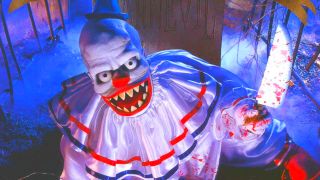
"It was as American as bubble gum inside hamburgers inside apple pie!" says Daniel Bigelow, part of the small team behind a little cult classic named CarnEvil. His description is as unique and strange as the game itself: a light gun shooter rife with gore and gallows humor, set inside a cursed combination of carnival, theme park, and three-ring circus. CarnEvil is emblematic of the kitsch and excess of the late '90s, a bygone era when arcades were prevalent in the West, shock value was a valid selling point, and Midway Games was raking in quarters with games like NFL Blitz and Gauntlet Legends. To think that the then-huge (now defunct) publisher would take a chance on a bizarre, macabre idea like CarnEvil is mind-boggling, even 20 years later. Stranger still is the fact that it was a success, unforgettable for anyone who's picked up its green-and-purple shotguns. CarnEvil is about more than mowing down hordes of belligerent clowns, though that's definitely a big part of it. "It's a classic for all the zombie soda jerks, rabid poodles, ghosts, and goblins," adds Bigelow. "What could be more American than shooting at the undead?"
At the time, Japanese developers seemed to have cornered the market on games featuring plastic firearms, with Sega's House of the Dead and Namco's Time Crisis set up in seemingly every arcade, bowling alley, and movie theater lobby across the nation. But much like Atari's Area 51, Midway's CarnEvil stood out as a distinctly Western creation amid all those glowing cabinets and their tethered toy weaponry, with exorbitant carnage and freakish characters greeting anyone who so much as glanced at the machine.
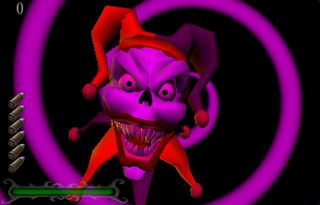
By most accounts, CarnEvil's debut coincided with Halloween 1998 - but this decades-old arcade game is a horror shooter for all seasons, with its ghoulish enemy designs, creepy backdrops, and delightfully demented atmosphere. For anyone who has yet to set foot on CarnEvil's unholy grounds, up to two players can take on four levels with distinct sideshow themes: Haunted House, Rickety Town, and Freak Show can be completed in any order before reaching the grand finale at the Big Top. Like most arcade games, it only takes about 30 minutes to play through, provided you brought enough skill and coin. There are classic trappings like innocent bystanders you shouldn't shoot - a recurring all-American damsel in distress named Betty, in CarnEvil's case - and weapon power-ups sprinkled throughout the stages, including rapid-fire machine gun ammo and skin-obliterating squirts of acid.
Zombies are but one small facet of CarnEvil's eccentric selection of enemies who you'll eviscerate with shotgun shells. You'll encounter maggots with human faces, conjoined twins who cartwheel towards you, and literal spider monkeys with eight arms - all of whom attack you during a single level. Rickety Town is especially varied, featuring the Christmas-themed Slay Ride, where vicious elves stab you with candy cane shivs while children sing gaily in the background. You'll hop aboard a ferris wheel affixed to a towering Paul Bunyan sculpture (complete with its own theme song), perforate some grisly Barney the Dinosaur parodies, gun down grinning gas station attendants, and finally face off against the evil Santa Claus-doppelganger Krampus. Whether or not you've already played it, CarnEvil is well worth watching all the way through.

Very little information about CarnEvil's hero is given anywhere in the game or its marketing, so it seems that players imagined up their own. In some dark, forgotten corner of the internet, a rumor started that the two players were named Jacob and Lisa - but Haeger is here to dispel such rumors, because the lone protagonist (no explanation for the second player) is simply an unnamed teenager. "I just wanted him to be an everyman character," he says.
As so bewitchingly illustrated in CarnEvil's attract mode cinematic, The Greatest Show Unearthed has sprung up in the fictional town of Greely Valley, Iowa. Ditching the haunted hayride of Spooky Sam's Ghost Tour, an unnamed teenager fulfills a local legend, locating a tombstone topped with a jester-capped skull and inserting a gleaming gold token into its fanged mouth. The disembodied head - who goes by Umlaut, and infamously taunts the player with foreboding rhymes during the intro to each level - suddenly springs to life, and CarnEvil is unleashed upon the world once more, trapping the protagonist in a nightmarish dimension ruled over by Professor Ludwig Von Tokkentakker (who's as difficult to defeat as his quarter-depleting name would suggest). Fun fact: the opening and ending cutscenes were created by Blur Studios in Santa Monica, with creative direction led by Tim Miller, who would later go on to direct Deadpool. Yes, really.
Real 'Horror Show'
It took a team of dedicated artists, programmers, and engineers to bring this arcade cabinet to life, but CarnEvil was born in the mind of Jack E. Haeger. "CarnEvil as a video game concept began for me as far back as 1988," says Haeger. "I was working with Eugene Jarvis [creator of seminal arcade games like Defender and Robotron: 2084] on Narc, and during the experiments we went through to make live digitized video a viable game platform, I started working with stop-motion puppets to push the format closer to a movie experience. I liked the premise of those classic horror movies where the teenager dares his friend to run through the graveyard."
Haeger's earliest sketch of his idea was entitled "Horror Show" (pictured below), featuring a poster with the CarnEvil name and the creepy, gnomish clown Smeek whose rictus grin would later be key to the final product's identity. This particular piece of concept art depicts a decrepit haunted house beckoning kids to come have a thrill and get scared out of their wits - not a far cry from the game it would eventually become, which entranced half-horrified, half-enchanted arcade-goers into spending a handful of quarters. "I knew we couldn't quite pull it off then," says Haeger, "but starting from a 'dark ride' theme - you're strapped in to a car and riding on a rail, shooting at pop-up targets - an 'evil' carnival theme had a lot of potential."
Sign up to the GamesRadar+ Newsletter
Weekly digests, tales from the communities you love, and more
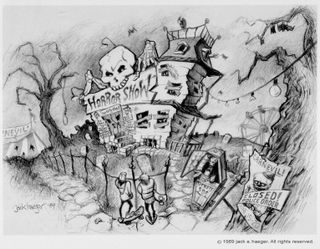
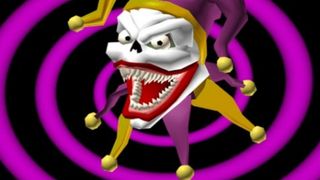
In another untraceable rumor, it was long thought that legendary voice actor Frank Welker - best known as Fred Jones on Scooby-Doo - provided the voice Umlaut. Not so. Haeger did the writing and acting honors for Umlaut himself, as well as the opening narration, Tokkentakker, Krampus, Hambone, and many more. But Umlaut is undoubtedly the most memorable baddie in the game, with his high-pitched voice, creepy couplets, and Joker-like laugh."I'm pretty much Umlaut 24/7 - even the stupid poems and puns," jokes Haeger.
Before CarnEvil came into its own, Midway had already dipped into light gun territory with two successful titles, both of which were co-directed by Haeger himself. Terminator 2: Judgment Day and its armies of T-800 endoskeletons made for one of those rare movie tie-ins that's fondly remembered by many, while Revolution X holds the distinction of being the only first-person shooter starring the rock band Aerosmith. "Management was looking to fill another opening in the production slot with another arcade gun game and approved my CarnEvil concept," Haeger recalls. From there, a crack team was assembled to make the game a reality, including people from all over Midway - some with a background in arcade games, others hailing from the pinball division.
Back to the drawing board
Scott Pikulski, an artist and 3D character designer on CarnEvil, still remembers the preliminary pitch that got snubbed by Midway's higher-ups. "The original game had a more 'Disney Haunted House' feel," he says. "There was an old caretaker character and a Punch and Judy-style puppet. After a harsh review from management, we decided to start over. The team came up with characters that were more aggressive, with a touch of dark humor." The first design to come out of the revamp was Hambone, a big brute with a Jason-esque hockey mask and a gatling gun arm who would later become the reanimating miniboss of the Haunted House stage.
"He set the tone for the game," says Pikulski. From Hambone's humble beginnings, Haeger and Pikulshi set to work designed the 40-plus characters who populated CarnEvil, which then had to be built in 3D Studio Max (a modeling tool that's still used for modern games in a far more advanced form). "Many ideas for characters and level content came from us just joking around while working on the game," remembers Pikulski. "It always felt like the project would be cancelled at any time, so we worked on it like we had nothing to lose. Jack has a great sense of humor, and many of the great ideas came from his head."
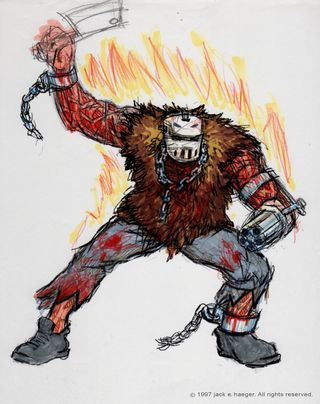
Inspirations seeped in from all over. Haeger's early sketches took on the spindly, angular vibe of Tim Burton's The Nightmare Before Christmas. Headshots in the black-and-white photobook ‘Fellini's Faces’ inspired the characters' highly expressive, distinctly creepy visages. In the deepest of cuts, Haeger even cites a surreal episode of The Avengers - think 1960s BBC, not Captain America - which follows the exploits of two murderous, gleefully wicked clowns. "The original development was more rail / target shooter and less graphic violence," says Haeger. "Mortal Kombat, meanwhile, was breaking records with over-the-top fatalities. We needed to 'shock things up,' and that's what we did."
And then some. "Lifelike Violence Strong" reads the blood-red label plastered across CarnEvil's cabinet, assigned by the American Amusement Machine Association, an arcade equivalent of the ESRB. In a guide from its March 1999 issue, Tips & Tricks magazine wrote that "CarnEvil is more than just the scariest shooter around, it's an awe-inspiring cinematic experience... the stunning 3D environments are portrayed in such gruesome detail, you will think you're trapped in a horror film." A few months later, L.A. Weekly called CarnEvil "undoubtedly the best of the genre" and "perhaps the most twisted video game ever created."

"I remember working late trying to get the vomit color and the awesome electrocution scene just right"
Scott Pikulski
Pikulski is the 3D modeling maestro behind many of the goriest graphics, from exposed rib cages and melted faces to heads cleaved in two by the player's shotgun spray. "In '98, 3D modeling was pretty basic, but we felt we were cutting edge," says Pikulski. "Each character was a series of objects... [which] made it very easy to swap a clean, undamaged arm for a damaged, gory one. As I got better at it, I kept pushing the gore. Then I started doing object swaps. This let me have a bone sticking out, or a hole straight through someone. I think the Mime character 'Mame' had many levels of gore, including spurting arteries. The character goes by too quick to truly appreciate it."
Bosses that couldn't help but court controversy
I can still vividly remember the first time I laid eyes on Tort and Rodz, two Freak Show enemies featured prominently in the gameplay portion of CarnEvil's attract mode. With their gaping wounds exposing raw muscle, leather S&M gear, and mouths and eyelids pulled back by hooks, these self-torturers could easily fit in with Hellraiser's Cenobites. At the tender age of 11, I wasn't quite able to process the mix of revulsion and fascination that such graphic cartoon gore invoked in me; I only knew that I had to play CarnEvil, provided I could build up the courage to approach such sensory overload. To this day, I'm still fascinated by all manner of creepy, twisted carnivals in games - and they're far more prevalent than you might think. "A good number of people are drawn to magic, dark rides, evil clowns, tattoos, and travelling circuses," says Haeger. "A good scare and a memorable adventure with friends is what we were hoping to deliver."
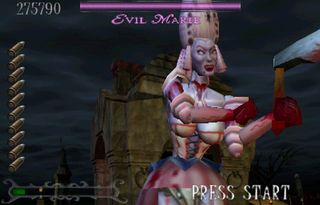
But Tort and Rodz are minor enemy types who may as well be footnotes compared to the two boss designs that stick with most players, for wildly different reasons. There's Junior, a colossal, zombified baby who awakens from a Frankenstein-style crib at the end of the Freak Show, and Evil Marie, a Victorian madame who lords over the Haunted House with her powdered wig and bloodied axe. Let's start with the latter: Evil Marie might be the earliest instance of 3D jiggle physics in a Western game, or certainly among the most infamous. As her breasts heave to and fro like hyperactive water balloons, your shots tear apart her maidenly gown, revealing dominatrix-style undergarments. Fire further, and you'll eventually blast her face clean off, before she's ultimately impaled on a pointy water fountain. It's gratuitous as can be, and a sure sign of how far the industry has come in the time since.
Meanwhile, Junior may be one of the only babies in all of video games who you need to repeatedly shoot in order to progress. And unlike the titanic toddlers in Zombies Ate My Neighbors, his flesh gets blasted off in blood-splattered chunks, before he's eventually electrocuted into a charred, diaper-clad husk once you've dealt enough damage. It's a wonder that conservative parents who latched onto the hysteria of violent games corrupting '90s youth didn't have a field day with CarnEvil's Junior. When he's not drenching the player in a volley of green barf, he's swinging his skull rattle or running around with an exposed, oozing eye socket.

"'Can you break this?' 'I don’t know, smash it against something hard!'"
Tom Kopera
"I remember working late trying to get the vomit color and the awesome electrocution scene just right," recalls Pikulski. "We had no objections to Junior until we showed the game to distributors, the German ones in particular. I think we were going for shock and humor, but in retrospect, Junior was too far on the shock side." As a compromise for more cautious arcade owners, the DIP switches in CarnEvil's programming allow operators to swap out Junior for Deaddy, a gigantic, deranged stuffed bear with all the same attack animations and pain sounds. Junior and his Deaddy counterpart didn't seem to make much of a splash beyond the confines of the arcade, all things considered; perhaps the general public was entirely desensitized to such digitized infant destruction by '98.
This is my boomstick
"Welcome to CarnEvil
We're visiting your town
No, that's not the walking dead
It's just a silly clown!
We open every midnight
and close before the dawn
Your mommy may come look for you
but by then we will be gone!"
So reads the sinister-sounding poem just beneath the start buttons on the CarnEvil arcade cabinet, nestled between two brightly colored pump-action shotguns. These were one of CarnEvil's biggest draws compared to the competition - they had heft, could be held comfortably in two hands, and the pump really did reload the gun in addition to the classic 'shoot off the screen' method. CarnEvil's unique firearms and their in-game sound effects - punchy booms and the squelchy ch-clak of a successful reload - are almost as memorable as the infernal amusement park itself. In a funny bit of parallel thought, CarnEvil has completely eclipsed Konami's 1998 light gun game Evil Night, which also boasted a shotgun - though only player two could wield it.

Tom Kopera, one of the engineers who designed CarnEvil's trademark guns, can attest that making sure these green and purple blasters were arcade-ready took some doing. "Packaging the electronics in there was not simple," he says. "Having it be able to be abused the way they could be abused, because it was just on a tether and we had electronics and stuff inside there... there were robust issues that we had to deal with. Just designing the plastic so that it could be smashed against a cabinet and not just shatter was interesting."
The methods for stress-testing such a pioneering piece of arcade tech to withstand the terrors of young children are hilarious. "We would just take it in the lab and beat on the bench!" laughs Kopera. "'Can you break this?' 'I don’t know, smash it against something hard!' We would do stuff like that, and then we would do more engineering-type testing, where we would set up pinball plungers and just smack it, smack it, smack it thousands of times to see if we could destroy the electronics inside or knock the optics out of it in relatively quick time. But a lot of our testing is 'kick it down the stairs' or 'push it off a truck' kinds of things."
Coming from a pinball background, Kopera can appreciate what a leap CarnEvil was when it came to Midway's policy on video game violence, having been scolded about implied bounty hunting while designing the Wild West-themed pinball table Cactus Canyon. "At one point there was a mode in the game where you had to kill the Bark Brothers as the Sheriff and get rid of the bad guys, and we took it out," he says. "The words 'Kill the Bark Brothers' [were met with] 'Oh my God, you can’t do that! You can’t print that!' And then here we are a year later blowing up babies, right? It’s like 'Wait a minute... I couldn’t have ‘Kill the Bark Brothers,’ but we can have this monster baby that you shoot with a shotgun?!"
Hurry, hurry, step right up to this magnificent cabinet
In what's become something of a lost art in the West, Daniel Bigelow designed the cabinet that physically houses CarnEvil, making this satanic sideshow shooting gallery portable. "Jack Haeger, the game's extraordinary director, knew what he wanted, and I was just honored to help a man of vision," he says. "He wanted his game to have some roots in turn of the century circus visuals mixed in with a classic, dime-store horror of the American Gothic aesthetic. We thought of the game box as a ticket booth at the front of the cemetery that comes to life. The action starts at that point in the game itself, so it was the perfect metaphor to drag you into the experience." It's hard to miss the cabinet's vaudevillian fiend painted across CarnEvil's gates, with Tokkentakker's zeppelin flying high overhead. That toothy scream-smile looks like a demonic version of Play-Doh's Dr. Drill 'N Fill dentistry set.

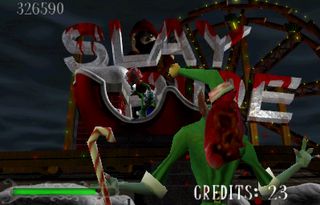
Rowan Atalla worked on the direction and animation for CarnEvil's background movies, which play out like a thrill ride while polygonal enemies populate the screen intermittently. The technology that makes this possible is deceivingly complex, and best interpreted by John Carmack-level intellects. "It's actually a pretty clever method," says Atalla. "Everything in the background (meaning everything that is not a character or power-up or special effect) is actually pre-rendered, but for each frame in the FMV, there were two sets of data - one was the colored image that you see shown on the screen, the other was the Z-buffer which contained depth information for every pixel shown in the frame." So, in layman's terms: getting a polygonal character model to fit properly within a pre-rendered FMV backdrop is damn difficult, especially when you're working with late '90s tech.
Of course, such nakedly infernal imagery was bound to displease a few folks. Martin Murphy, who worked on CarnEvil's 3D animation and motion capture (and brokered the deal with Blur Studios), recalls a trip to the cabinet production facility where he met one particularly unhappy onlooker. "I’m there waiting in the manufacturing line, and some of the gals who worked there - they’re from Chicago, and they were talking in Spanish. I’m hearing them talk, and I know some Spanish, and I hear something like 'Es feo...' - 'It’s ugly.' And I’m like 'What’s this about?' So I started talking to this woman, and I go 'Hey, what do you think?' She looks at me and she goes 'Es Diablo, es feo!' She goes [spitting noise] and starts cursing it," he laughs. "When we went to the trade shows, it was... maybe it’s all just part of the art of negotiation, but it was a tough sell, especially for the South."
As part of the faculty at Ringling College of Art + Design (founded by one of the Ringling Bros. circus moguls), Murphy gets the chance to incorporate CarnEvil into his curriculum here and there. "The last time CarnEvil came up in a classroom situation was the notion that the player’s going to want more instant hit-reacts or nut shots," he says. "The biggest life lesson about making games - it started with Hambone. Each part of his body had a special hit-react, and because of the speed in which people shoot him... anticipating those kind of interrupts in an animation, getting the visual variety, that’s one thing that rewards a player for their tenure." Who knew that seeing enemies grab their groin in pain when you blast their bits could have such deep-seated importance for player feedback? GoldenEye 007 on Nintendo 64 knew it, CarnEvil knew it, and now you know it.
You can't take the carnival home with you
To this day, finding a CarnEvil arcade machine or buying your own is still the only way to play it without venturing into the hazy legality of emulation territory. It seems odd, because series like House of the Dead, Time Crisis, and Point Blank all managed to carve a niche for themselves on home consoles, complete with their own plastic gun peripherals. "There was a home game in development," says Pikulski, "but instead of a straight port, the company doing it wanted to create an original game using the IP. It was very strange."
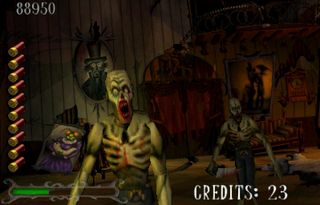

Martin Martinez, who worked on CarnEvil's art and textures, passed away in the years since the game's launch - but his voice lives on in Haeger's favorite character, Muertito the Bat Boy. "The late Marty Martinez came up with this character for the Big Top, and in one of our regular 'Can you top this?' character/game design sessions, I can still hear Martin's warm laughter and wonderful smile, says Haeger. "Muertito pretty well sums up the fun and crazy spirit we had as a team." In another bit of virtual life after death, you can spot Martinez cheering in the crowd whenever a goal is scored in Midway's NHL arcade game 2 On 2 Open Ice Challenge.
In what would've been a perfect fit, CarnEvil was even being concepted for one of those 4D rides you'll sometimes see at amusement centers, with patrons strapping into a hydraulic seat that moves with the roller-coaster motions on-screen, similar to Disneyland's Star Tours. "The original Midway Arcade Team focused on developing a Consumer treatment soon after concluding development on CarnEvil - especially after hearing that our sales had exceeded Mortal Kombat 4 Arcade," says Haeger. "The broad concept was that you'd enter Greely Valley Cemetery on the Haunted Hayride with several of your friends. Trapped inside, it was up to you to rescue everyone before sunrise. Bonus waves including a river ride were included."
Sadly, the 4D ride never made it to market - though I wonder if footage of that hayride still exists in a dusty archive somewhere. As to who currently owns the CarnEvil rights after Midway filed for bankruptcy in 2009, Haeger isn't sure. "Think it's all buried under a rock in Iowa somewhere, and only Warner Bros [which purchased most of Midway's assets] knows the legend," he says.
Chronicling at the Greely Valley Cemetery
Though CarnEvil's lore and legacy only produced a single game, it continues to capture the minds of players who fondly remember its scares. ColourBlindZebra - real name withheld - is one such fan, who maintains the Greely Valley Cemetery fansite with a user named CarnEvilCrazy. Since September 2015, the site has documented everything there is to know about CarnEvil in staggering detail, archiving its concept sketches, promotional art, music tracks, and even individual voice clips. "I think when I first wanted to make the site was when I was given the collection of enemy character posters," says Zebra. "Finally seeing all the character names after so long was fascinating, and I wanted to share them with everyone."
He's even gone so far as to plumb the depths of the game's files in search of content that never saw the light of day. "There's a filecheck in the diagnostics menu, so I've got a pretty good idea of things that are in there as far as textures and models are concerned," he says. "Personally, I'm really proud of finding the unused voice clips for the [undead frycook] Guilloteens. They're one of my favorite enemies as it is, and finding that at some point they had a completely different, 'surfer dude' voice is so cool." Zebra's method for locating unused bits of audio is ingenious, utilizing emulated versions of CarnEvil to ensure that no stone is left unturned, no soundbite unheard.
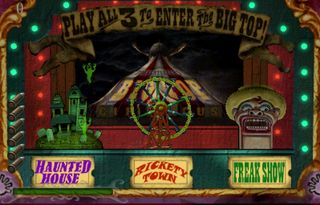
"CarnEvil was the perfect fit for arcades, able to draw attention through the kind of shock and awe that pulls in passersby like a magnet."
"When you select a level, the sound files for the associated level are loaded while Umlaut says his rhyme," he explains. "After this, if you load a save state from another level, the sounds from the previous level will still play." For example, if you booted up the Haunted House, then loaded up a save state in Rickety Town, the game can't keep up, and Evil Marie's voice clips will play on the grey-skinned garishly grinning gas jockey Smiling Bob. Through fastidious trial and error, Zebra has managed to uncover plenty of scrapped voiceover lines still lying dormant in CarnEvil's code. "The only unused voice clip for Smiling Bob I could find was when, by something crazy, the voice clips for Rickety Town were loaded onto themselves, but incorrectly, and so the voice clips were jumbled up, and the unused clip managed to appear," he says with pride. To the game's devotees, uncovering these unused bits of CarnEvil is like digging up a precious gem, and Zebra's online museum is the perfect way to exhibit them for all to enjoy.
When the Moon is full and the trees are bare...
We may never get a CarnEvil 2, but its influence lives on, with plenty of similarly gory, darkly humorous games partially scratching the same itch. The two Killing Floor games essentially become CarnEvil's spiritual successors during the annual Summer Sideshow event, which dresses up its rotting, superpowered specimens in gloriously gaudy circus outfits. Painkiller's Battle out of Hell expansion pack gave us Loony Park, with dilapidated death rides and bloodthirsty, diminutive clowns who would fit right in with Tokkentakker's posse. And PlayStation VR shooter Until Dawn: Rush of Blood echoes CarnEvil's sinister roller-coasters and sideshow themes, albeit with a full-on horror vibe in lieu of any humor.
CarnEvil wonderfully captures our fascination with fear, which powers many of the thrills you'll find in any real-world amusement park. The adrenaline rush that comes with the sudden plunge of a coaster cart; jump scares in the narrow hallways of a dingy dark ride; the vague unease of being near the carnies working the guts of grimy, creaky machinery. Like Mortal Kombat, Splatterhouse, or Chiller, CarnEvil was the perfect fit for arcades, able to draw attention through the kind of shock and awe that pulls in passersby like a magnet. It's the epitome of a cult classic, produced during the crest of Midway's success and destined to be revered by nostalgic arcade-goers for generations.
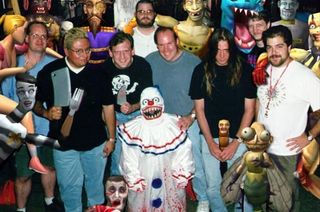
"CarnEvil was intended to be a thrilling escape and hopefully provide a chuckle or two," says Haeger. "I just can't express my gratitude [to the team] for making this twisted concept a reality. It was for its time."
"CarnEvil took our blood, sweat, and tears, but it was also a lot of fun," says Pikulski.
"There were more people from Midway at my father’s funeral than my own extended family, so Midway just meant a lot to me, and so did this team," remembers Murphy.
Zebra understands the allure of this evil carnival; as a kid, he would scope out the location of CarnEvil's cabinet in order to avoid it, and spare himself the terrors projecting from its screen. Yet despite his feelings of dread, fascination always took over, and he'd keep returning to CarnEvil - a bit like CarnEvil's protagonist, who brazenly slides the golden token back into Umlaut's mouth after slaying Tokkentakker, hoping to relive the nightmare that's only just ended. "You get captivated by it," says Zebra. "And as dumb an idea as it is, you're gonna keep coming back."
For more miraculous stories on how games got made, read our feature about how relentless passion (and remortgaging of houses) made Cuphead a reality.









Lucas Sullivan is the former US Managing Editor of GamesRadar+. Lucas spent seven years working for GR, starting as an Associate Editor in 2012 before climbing the ranks. He left us in 2019 to pursue a career path on the other side of the fence, joining 2K Games as a Global Content Manager. Lucas doesn't get to write about games like Borderlands and Mafia anymore, but he does get to help make and market them.
Most Popular



![Arcade Longplay [225] CarnEvil - YouTube](https://img.youtube.com/vi/gBMslh22Vr0/maxresdefault.jpg)
